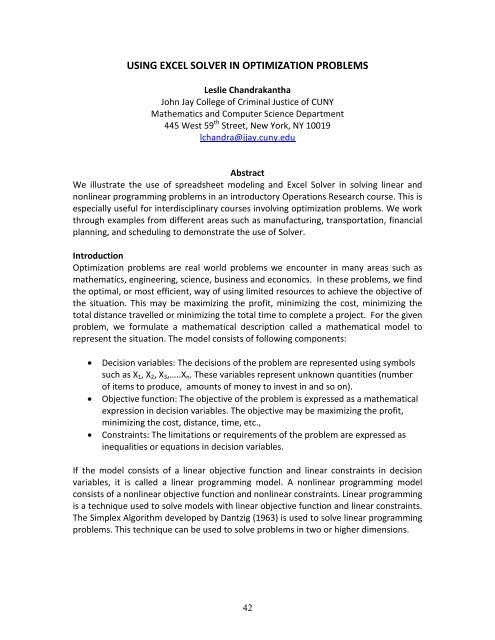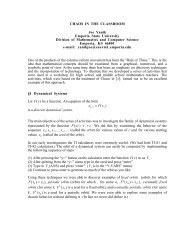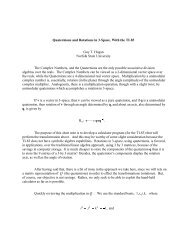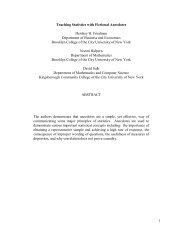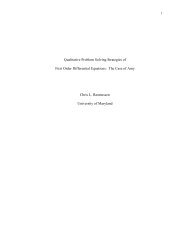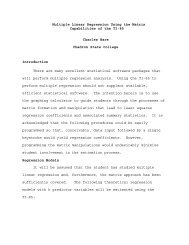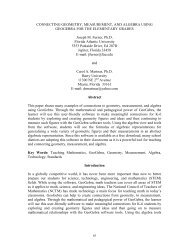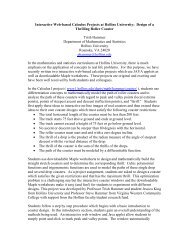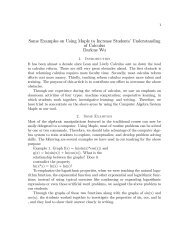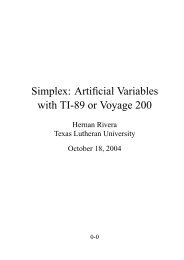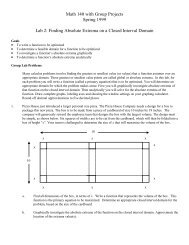using excel solver in optimization problems - Mathematics Archives
using excel solver in optimization problems - Mathematics Archives
using excel solver in optimization problems - Mathematics Archives
Create successful ePaper yourself
Turn your PDF publications into a flip-book with our unique Google optimized e-Paper software.
USING EXCEL SOLVER IN OPTIMIZATION PROBLEMS<br />
Leslie Chandrakantha<br />
John Jay College of Crim<strong>in</strong>al Justice of CUNY<br />
<strong>Mathematics</strong> and Computer Science Department<br />
445 West 59 th Street, New York, NY 10019<br />
lchandra@jjay.cuny.edu<br />
Abstract<br />
We illustrate the use of spreadsheet model<strong>in</strong>g and Excel Solver <strong>in</strong> solv<strong>in</strong>g l<strong>in</strong>ear and<br />
nonl<strong>in</strong>ear programm<strong>in</strong>g <strong>problems</strong> <strong>in</strong> an <strong>in</strong>troductory Operations Research course. This is<br />
especially useful for <strong>in</strong>terdiscipl<strong>in</strong>ary courses <strong>in</strong>volv<strong>in</strong>g <strong>optimization</strong> <strong>problems</strong>. We work<br />
through examples from different areas such as manufactur<strong>in</strong>g, transportation, f<strong>in</strong>ancial<br />
plann<strong>in</strong>g, and schedul<strong>in</strong>g to demonstrate the use of Solver.<br />
Introduction<br />
Optimization <strong>problems</strong> are real world <strong>problems</strong> we encounter <strong>in</strong> many areas such as<br />
mathematics, eng<strong>in</strong>eer<strong>in</strong>g, science, bus<strong>in</strong>ess and economics. In these <strong>problems</strong>, we f<strong>in</strong>d<br />
the optimal, or most efficient, way of <strong>us<strong>in</strong>g</strong> limited resources to achieve the objective of<br />
the situation. This may be maximiz<strong>in</strong>g the profit, m<strong>in</strong>imiz<strong>in</strong>g the cost, m<strong>in</strong>imiz<strong>in</strong>g the<br />
total distance travelled or m<strong>in</strong>imiz<strong>in</strong>g the total time to complete a project. For the given<br />
problem, we formulate a mathematical description called a mathematical model to<br />
represent the situation. The model consists of follow<strong>in</strong>g components:<br />
• Decision variables: The decisions of the problem are represented <strong>us<strong>in</strong>g</strong> symbols<br />
such as X 1 , X 2 , X 3 ,…..X n . These variables represent unknown quantities (number<br />
of items to produce, amounts of money to <strong>in</strong>vest <strong>in</strong> and so on).<br />
• Objective function: The objective of the problem is expressed as a mathematical<br />
expression <strong>in</strong> decision variables. The objective may be maximiz<strong>in</strong>g the profit,<br />
m<strong>in</strong>imiz<strong>in</strong>g the cost, distance, time, etc.,<br />
• Constra<strong>in</strong>ts: The limitations or requirements of the problem are expressed as<br />
<strong>in</strong>equalities or equations <strong>in</strong> decision variables.<br />
If the model consists of a l<strong>in</strong>ear objective function and l<strong>in</strong>ear constra<strong>in</strong>ts <strong>in</strong> decision<br />
variables, it is called a l<strong>in</strong>ear programm<strong>in</strong>g model. A nonl<strong>in</strong>ear programm<strong>in</strong>g model<br />
consists of a nonl<strong>in</strong>ear objective function and nonl<strong>in</strong>ear constra<strong>in</strong>ts. L<strong>in</strong>ear programm<strong>in</strong>g<br />
is a technique used to solve models with l<strong>in</strong>ear objective function and l<strong>in</strong>ear constra<strong>in</strong>ts.<br />
The Simplex Algorithm developed by Dantzig (1963) is used to solve l<strong>in</strong>ear programm<strong>in</strong>g<br />
<strong>problems</strong>. This technique can be used to solve <strong>problems</strong> <strong>in</strong> two or higher dimensions.<br />
42
In this paper we show how to use spreadsheet model<strong>in</strong>g and Excel Solver for solv<strong>in</strong>g<br />
l<strong>in</strong>ear and nonl<strong>in</strong>ear programm<strong>in</strong>g <strong>problems</strong>.<br />
Spreadsheet Model<strong>in</strong>g and Excel Solver<br />
A mathematical model implemented <strong>in</strong> a spreadsheet is called a spreadsheet model.<br />
Major spreadsheet packages come with a built-<strong>in</strong> <strong>optimization</strong> tool called Solver. Now<br />
we demonstrate how to use Excel spreadsheet model<strong>in</strong>g and Solver to f<strong>in</strong>d the optimal<br />
solution of <strong>optimization</strong> <strong>problems</strong>.<br />
If the model has two variables, the graphical method can be used to solve the model.<br />
Very few real world <strong>problems</strong> <strong>in</strong>volve only two variables. For <strong>problems</strong> with more than<br />
two variables, we need to use complex techniques and tedious calculations to f<strong>in</strong>d the<br />
optimal solution. The spreadsheet and <strong>solver</strong> approach makes solv<strong>in</strong>g <strong>optimization</strong><br />
<strong>problems</strong> a fairly simple task and it is more useful for students who do not have strong<br />
mathematics background.<br />
The first step is to organize the spreadsheet to represent the model. We use separate<br />
cells to represent decision variables, create a formula <strong>in</strong> a cell to represent the objective<br />
function and create a formula <strong>in</strong> a cell for each constra<strong>in</strong>t left hand side. Once the<br />
model is implemented <strong>in</strong> a spreadsheet, next step is to use the Solver to f<strong>in</strong>d the<br />
solution. In the Solver, we need to identify the locations (cells) of objective function,<br />
decision variables, nature of the objective function (maximize/m<strong>in</strong>imize) and<br />
constra<strong>in</strong>ts.<br />
Example One (L<strong>in</strong>ear model): Investment Problem<br />
Our first example illustrates how to allocate money to different bonds to maximize the<br />
total return (Ragsdale 2011, p. 121).<br />
A trust office at the Blacksburg National Bank needs to determ<strong>in</strong>e how to <strong>in</strong>vest<br />
$100,000 <strong>in</strong> follow<strong>in</strong>g collection of bonds to maximize the annual return.<br />
Bond<br />
Annual Maturity Risk Tax-Free<br />
Return<br />
A 9.5% Long High Yes<br />
B 8.0% Short Low Yes<br />
C 9.0% Long Low No<br />
D 9.0% Long High Yes<br />
E 9.0% Short High No<br />
The officer wants to <strong>in</strong>vest at least 50% of the money <strong>in</strong> short term issues and no more<br />
than 50% <strong>in</strong> high-risk issues. At least 30% of the funds should go <strong>in</strong> tax-free <strong>in</strong>vestments,<br />
and at least 40% of the total return should be tax free.<br />
Creat<strong>in</strong>g the L<strong>in</strong>ear Programm<strong>in</strong>g model to represent the problem:<br />
Decision variables are the amounts of money should be <strong>in</strong>vested <strong>in</strong> each bond.<br />
X 1 = Amount of money to <strong>in</strong>vest <strong>in</strong> Bond A<br />
43
X 2 = Amount of money to <strong>in</strong>vest <strong>in</strong> Bond B<br />
X 3 = Amount of money to <strong>in</strong>vest <strong>in</strong> Bond C<br />
X 4 = Amount of money to <strong>in</strong>vest <strong>in</strong> Bond D<br />
X 5 = Amount of money to <strong>in</strong>vest <strong>in</strong> Bond E<br />
Objective Function:<br />
Objective is to maximize the total annual return.<br />
Maximize f(X 1 , X 2 , X 3 , X 4 , X 5 ) = 9.5%X 1 + 8%X 2 + 9%X 3 + 9%X 4 + 9%X 5<br />
Constra<strong>in</strong>ts:<br />
Total <strong>in</strong>vestment:<br />
X 1 + X 2 + X 3 + X 4 + X 5 = 100,000.<br />
At least 50% of the money goes to short term issues:<br />
X 2 + X 5 >= 50,000.<br />
No more than 50% of the money should go to high risk issues:<br />
X 1 + X 4 + X 5 = 30,000.<br />
At least 40% of the total annual return should be tax free:<br />
9.5%X 1 + 8%X 2 + 9%X 4 >= 40%(9.5%X 1 + 8%X 2 + 9%X 3 + 9%X 4 + 9%X 5 )<br />
Nonnegativity constra<strong>in</strong>ts (all the variables should be nonnegative):<br />
X 1 , X 2 , X 3 , X 4 , X 5 >= 0.<br />
Complete l<strong>in</strong>ear programm<strong>in</strong>g model:<br />
Max: .095X 1 + .08X 2 + .09X 3 +.09X 4 + .09X 5<br />
Subject to:<br />
X 1 + X 2 + X 3 + X 4 + X 5 = 100,000.<br />
X 2 + X 5 >= 50,000.<br />
X 1 + X 4 + X 5 = 30,000.<br />
9.5%X 1 + 8%X 2 + 9%X 4 >= 40%(9.5%X 1 + 8%X 2 + 9%X 3 + 9%X 4 + 9%X 5 )<br />
X 1 , X 2 , X 3 , X 4 , X 5 >= 0.<br />
Spreadsheet model and Solver implementation:<br />
Implement<strong>in</strong>g the problem <strong>in</strong> an Excel spreadsheet and Solver formulation produces the<br />
follow<strong>in</strong>g spreadsheet and Solver parameters. The cells B6 through B10 represent the<br />
five decision variables. The cell C13 represents the objective function. The cells B11,<br />
E11, G11, I11, B14, and B15 represent the constra<strong>in</strong>t left hand sides. The nonnegativity<br />
constra<strong>in</strong>t is not implemented <strong>in</strong> the spreadsheet and it can be implemented <strong>in</strong> the<br />
Solver. The complete set of constra<strong>in</strong>ts, target cell (objective function cell), variable cells<br />
(chang<strong>in</strong>g cells) and whether to maximize or m<strong>in</strong>imize the objective function are<br />
identified <strong>in</strong> the Solver parameters box.<br />
44
Figure 1: Spreadsheet implementation of example one<br />
Figure 2: Solver implementation of example one<br />
Figure 3: Spreadsheet with optimal solution of example one<br />
45
Optimal money allocation:<br />
Amount <strong>in</strong>vested <strong>in</strong> Bond A = X 1 = $20, 339.<br />
Amount <strong>in</strong>vested <strong>in</strong> Bond B = X 2 = $20, 339.<br />
Amount <strong>in</strong>vested <strong>in</strong> Bond C = X 3 = $29, 661.<br />
Amount <strong>in</strong>vested <strong>in</strong> Bond D = X 4 = $0.<br />
Amount <strong>in</strong>vested <strong>in</strong> Bond E = X 5 = $29, 661.<br />
The Maximum annual return is $8,898.00<br />
Example Two (Nonl<strong>in</strong>ear model): Network Flow Problem<br />
This example illustrates how to f<strong>in</strong>d the optimal path to transport hazardous material (<br />
Ragsdale, 2011, p.367)<br />
Safety Trans is a truck<strong>in</strong>g company that specializes transport<strong>in</strong>g extremely valuable and<br />
extremely hazardous materials. Due to the nature of the bus<strong>in</strong>ess, the company places<br />
great importance on ma<strong>in</strong>ta<strong>in</strong><strong>in</strong>g a clean driv<strong>in</strong>g safety record. This not only helps keep<br />
their reputation up but also helps keep their <strong>in</strong>surance premium down. The company is<br />
also conscious of the fact that when carry<strong>in</strong>g hazardous materials, the environmental<br />
consequences of even a m<strong>in</strong>or accident could be disastrous.<br />
Safety Trans likes to ensure that it selects routes that are least likely to result <strong>in</strong> an<br />
accident. The company is currently try<strong>in</strong>g to identify the safest routes for carry<strong>in</strong>g a load<br />
of hazardous materials from Los Angeles to Amarillo, Texas. The follow<strong>in</strong>g network<br />
summarizes the routes under consideration. The numbers on each arc represent the<br />
probability of hav<strong>in</strong>g an accident on each potential leg of the journey.<br />
Las Vegas<br />
0.003<br />
Los Angeles<br />
1<br />
3<br />
2<br />
0.004 0.002<br />
0.006<br />
0.010 0.006<br />
4<br />
6<br />
5<br />
7<br />
Figure 4: Network diagram of example two<br />
8<br />
0.001<br />
Amarillo<br />
0.002<br />
0.010 0.004<br />
0.006<br />
0.009<br />
Phoenix<br />
San Diego<br />
0.010<br />
Tucson<br />
Flagstaff<br />
0.001<br />
Albuquerque<br />
10<br />
0.005<br />
0.002<br />
0.003<br />
Las Cruces<br />
9<br />
0.003<br />
Lubbock<br />
46
The objective is to f<strong>in</strong>d the route that m<strong>in</strong>imizes the probability of hav<strong>in</strong>g an accident, or<br />
equivalently, the route that maximizes the probability of not hav<strong>in</strong>g an accident.<br />
Creat<strong>in</strong>g the mathematical model to represent the problem:<br />
Each decision variable <strong>in</strong>dicates whether or not a particular route is taken (they are<br />
known as b<strong>in</strong>ary variables). We will def<strong>in</strong>e these variables <strong>in</strong> follow<strong>in</strong>g way:<br />
X ij = 1 , if the route from node i to node j is selected, and X ij = 0 otherwise.<br />
Let P ij be the probability of hav<strong>in</strong>g an accident while travell<strong>in</strong>g from node i to node j<br />
(1- P ij is the probability of not hav<strong>in</strong>g an accident).<br />
Objective function:<br />
M<strong>in</strong>imize the probability of hav<strong>in</strong>g an accident or equivalently, maximize the probability<br />
of not hav<strong>in</strong>g an accident. Note that this objective function is nonl<strong>in</strong>ear.<br />
Maximize f(X 12 , X 13 ,….) = (1-P 12 *X 12 ) (1-P 13 *X 13 ) (1 – P 14 *X 14 ) (1 – P 24 *X 24 ) ………. (1 -<br />
P 9.10 *X 9,10 )<br />
Constra<strong>in</strong>ts:<br />
We use the follow<strong>in</strong>g strategy to construct constra<strong>in</strong>ts: That is, supply one unit at the<br />
start<strong>in</strong>g node and demand one unit at the end<strong>in</strong>g node, and for every other node,<br />
demand or supply is zero. We f<strong>in</strong>d the route <strong>in</strong> which the one unit travels.<br />
Total supply = 1, and total demand = 1, so for each node,<br />
Net flow (Inflow – Outflow) = demand or supply for that node (Balance of flow rule).<br />
Then we have follow<strong>in</strong>g set of constra<strong>in</strong>ts:<br />
Node 1: - X 12 – X 13 – X 14 = -1<br />
Node 2: + X 12 – X 24 – X 26 = 0<br />
Node 3: + X 13 – X 34 – X 35 = 0<br />
Node 4: + X 14 + X 24 + X 34 – X 45 – X 46 – X 48 = 0<br />
Node 5: + X 35 + X 45 – X 57 = 0<br />
Node 6: + X 26 + X 46 - X 67 – X 68 = 0<br />
Node 7: + X 57 + X 67 – X 78 – X 7,10 = 0<br />
Node 8: + X 48 + X 68 + X 78 – X 8,10 = 0<br />
Node 9: + X 79 – X 9,10 = 0<br />
Node 10: + X 7,10 + X 8,10 + X 9,10 = 1<br />
Complete nonl<strong>in</strong>ear Programm<strong>in</strong>g model:<br />
Maximize: (1-P 12 *X 12 ) (1-P 13 *X 13 ) (1 – P 14 *X 14 ) (1 – P 24 *X 24 ) ………. (1-P 9.10 *X 9,10 )<br />
Subject to:<br />
- X 12 – X 13 – X 14 = -1<br />
+ X 12 – X 24 – X 26 = 0<br />
+ X 13 – X 34 – X 35 = 0<br />
47
+ X 14 + X 24 + X 34 – X 45 – X 46 – X 48 = 0<br />
+ X 35 + X 45 – X 57 = 0<br />
+ X 26 + X 46 - X 67 – X 68 = 0<br />
+ X 57 + X 67 – X 78 – X 7,10 = 0<br />
+ X 48 + X 68 + X 78 – X 8,10 = 0<br />
+ X 79 – X 9,10 = 0<br />
+ X 7,10 + X 8,10 + X 9,10 = 1<br />
All X ij are b<strong>in</strong>ary.<br />
Spreadsheet model and Solver implementation:<br />
Figure 5: Spreadsheet implementation of example Two<br />
Figure 6: Solver implementation of example two<br />
48
Figure 7: Spreadsheet with optimal solution of example two<br />
The optimal path:<br />
The route that m<strong>in</strong>imizes the probability of hav<strong>in</strong>g an accident is given below:<br />
Los Angeles to Phoenix<br />
Phoenix to Flagstaff<br />
Flagstaff to Albuquerque<br />
Albuquerque to Amarillo.<br />
Conclusion:<br />
Optimization <strong>problems</strong> <strong>in</strong> many fields can be modeled and solved <strong>us<strong>in</strong>g</strong> Excel Solver. It<br />
does not require knowledge of complex mathematical concepts beh<strong>in</strong>d the solution<br />
algorithms. This way is particularly helpful for students who are non math majors and<br />
still want to take theses courses.<br />
References:<br />
1) Cliff T. Ragsdale, 2011, Spreadsheet Model<strong>in</strong>g and Decision Analysis, 6 th Edition.<br />
SOUTH-WESTERN, Cengage Learn<strong>in</strong>g.<br />
2) Dantzig, G. B. 1963, L<strong>in</strong>ear Programm<strong>in</strong>g and Extensions, Pr<strong>in</strong>ceton University<br />
Press, Pr<strong>in</strong>ceton, NJ.<br />
3) John Walkenbach, 2007, Excel 2007 Formulas, John Wiley and Sons.<br />
49


